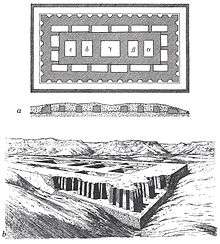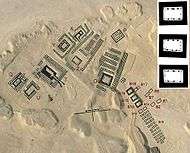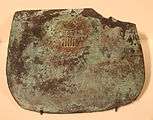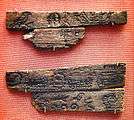Hor-Aha
| Hor-Aha | ||||||||||||||||||
|---|---|---|---|---|---|---|---|---|---|---|---|---|---|---|---|---|---|---|
| Aha | ||||||||||||||||||
 Faience vessel fragment with serekh inscribed with the Horus-name Aha, on display at the British Museum. | ||||||||||||||||||
| Pharaoh | ||||||||||||||||||
| Reign | 31st century BC (1st Dynasty) | |||||||||||||||||
| Predecessor | Narmer | |||||||||||||||||
| Successor | Djer | |||||||||||||||||
| ||||||||||||||||||
| Consort | Benerib, Khenthap | |||||||||||||||||
| Children | Djer | |||||||||||||||||
| Father | Narmer ? | |||||||||||||||||
| Burial | Chambers B10, B15, B19, Umm el-Qa'ab | |||||||||||||||||
Hor-Aha (or Aha or Horus Aha) is considered the second pharaoh of the First Dynasty of Egypt. He lived around the 31st century BC and is thought to have had a long reign.
Identity
Name
The commonly used name Hor-Aha is a rendering of the pharaoh's Horus-name, an element of the royal titulary associated with the god Horus, and is more fully given as Horus-Aha meaning Horus the Fighter.[1]
The Greek historian Manetho's record "Aegyptiaca" (translating to History of Egypt) lists his Greek name as Athothis, or "Athotís".
For the Early Dynastic Period, the archaeological record refers to the pharaohs by their Horus-names, while the historical record, as evidenced in the Turin and Abydos king lists, uses an alternative royal titulary, the nebty-name.[1][2] The different titular elements of a pharaoh's name were often used in isolation, for brevity's sake, although the choice varied according to circumstance and period.[2]
Mainstream Egyptological consensus follows the findings of Petrie in reconciling the two records and connects Hor-Aha (archaeological) with the nebty-name Ity (historical).[1][2][3]
The same process has led to the identification of the historical Menes (a nebty-name) with Narmer (a Horus-name) evidenced in the archaeological record (both figures are credited with the unification of Egypt and as the first pharaoh of Dynasty I) as the predecessor of Hor-Aha (the second pharaoh).[1][2][3]
Theories
There has been some controversy about Hor-Aha. Some[4] believe him to be the same individual as the legendary Menes and that he was the one to unify all of Egypt. Others claim he was the son of Narmer, the pharaoh who unified Egypt. Narmer and Menes may have been one pharaoh, referred to with more than one name. Regardless, considerable historical evidence from the period points to Narmer as the pharaoh who first unified Egypt (see Narmer Palette) and to Hor-Aha as his son and heir.
Reign
Successor to Narmer
Seal impressions discovered by G. Dreyer in the Umm el-Qa'ab from Merneith and Qa'a burials identify Hor-Aha as the second pharaoh of the first dynasty.[5] His predecessor Narmer had united Upper Egypt and Lower Egypt into a single kingdom. Hor-Aha probably ascended the throne in the late 32nd or early 31st century.
Interior policy
Hor-Aha seems to have conducted many religious activities. A visit to a shrine of the goddess Neith is recorded on several tablets from his reign.[6] The sanctuary of Neith he visited was located in the north-east of the Nile Delta at Sais.[7] Furthermore, the first known representation of the sacred Henu-bark of the god Seker was found engraved on a year tablet dating from his reign.[8]

Vessel inscriptions, labels and sealings from the graves of Hor-Aha and Queen Neithhotep suggest that this queen died during the reign of Aha. He arranged for her burial in a magnificent mastaba excavated by Jacques de Morgan.[9] Queen Neithhotep is plausibly Aha's mother[10] The selection of the cemetery of Naqada as the resting place of Neithhotep is a strong indication that she came from this province. This, in turn, supports the view that Narmer married a member of the ancient royal line of Naqada to strengthen the domination of the Thinite kings over the region.[7] However, in January 2016, a rock inscription has demonstrated that Neithhotep was actually a queen regent early during the reign of Djer, Hor-Aha's successor.[11] Therefore, the cemetery evidence above only proves that Neithhotep did live during the reign of Hor-Aha but succeeded him into Djer's reign.
Most importantly, the oldest mastaba at the North Saqqara necropolis of Memphis dates to his reign. The mastaba belongs to an elite member of the administration who may have been a relative of Hor-Aha, as was customary at the time.[7] This is a strong indication of the growing importance of Memphis during Aha's reign.
Economic development
Few artifacts remain of Hor-Aha's reign. However, the finely executed copper-axe heads, faience vessel fragments,[12] ivory box and inscribed white marbles all testify to the flourishing of craftsmanship during Aha's time in power.[7]
Activities outside Egypt
Inscription on an ivory tablet from Abydos suggests that Hor-Aha led an expedition against the Nubians. On a year tablet, a year is explicitly called 'Year of smiting of Ta-Sety' (i.e. Nubia).[13]
During Hor-Aha's reign, trade with the Southern Levant seems to have been on the decline. Contrary to his predecessor Narmer, Hor-Aha is not attested outside of the Nile Valley. This may point to a gradual replacement of long-distance trade between Egypt and its eastern neighbors by a more direct exploitation of the local resources by the Egyptians. Vessel fragment analysis from an Egyptian outpost at En Besor suggests that it was active during Hor-Aha's reign. Other Egyptian settlements are known to have been active at the time as well (Byblos and along the Lebanese coast). Finally, Hor-Aha's tomb yielded vessel fragments from the Southern Levant.[14]
Family

Hor-Aha's chief wife was Benerib, whose name was "written alongside his on a number of [historical] pieces, in particular, from tomb B14 at Abydos, Egypt".[15][16][17] Tomb B14 is located directly adjacent to Hor-Aha's sepulchre.[18] Hor-Aha also had another wife, Khenthap,[19] with whom he became father of Djer. She is mentioned as Djer's mother on the Cairo Annals Stone.
Tomb

The tomb of Hor-Aha is located in the necropolis of the kings of the 1st Dynasty at Abydos, known as the Umm el-Qa'ab. It comprises three large chambers B10 B15 and B19 which are directly adjacent to Narmer's tomb.[20] The chambers are rectangular, directly dug in the desert floor, their walls lined with mud bricks. The tombs of Narmer and Ka had only two adjacent chambers, while the tomb of Hor-Aha comprises three substantially larger yet separated chambers. The reason for this architecture is that it was difficult at that time to build large ceilings above the chambers, as timber for these structures often had to be imported from Palestine.
A striking innovation of Hor-Aha's tomb is that members of the royal household were buried with the pharaoh, the earliest known retainer sacrifices in Egypt. It is unclear if they were killed or committed suicide. Among those buried were servants, dwarfs, women and even dogs. A total of 36 subsidiary burials were laid out in three parallel rows north-east of Hor-Aha's main chambers. As a symbol of royalty Hor-Aha was even given a group of young lions.
Gallery
-

Cylinder vessel of Hor-Aha from Saqqara, First Dynasty; Museum August Kestner.
-

Copper tool bearing the serekh of Hor-Aha, on display at the Egyptian Museum of Berlin.
-
Ivory label inscribed with the serekh of Hor-Aha and bearing the name of his wife Benerib.
-

Ivory label bearing the serekh of Hor-Aha. It reports the victory over the "arch-using setjet-folks" (center) and the visit at the domain "Horus thrives with the cattles" (right).
-

Fragmented ebony label of Hor-Aha relating a visit of the king to the shrine of the goddess Neith of Sais in the Delta, British Museum.
See also
- Ancient Egypt
- Ancient Egyptian retainer sacrifices
- First dynasty of Egypt
- History of Egypt
- List of Pharaohs
- Menes
- Narmer
- Pharaoh
- The Greatest Pharaohs
References
- 1 2 3 4 Edwards 1971: 13
- 1 2 3 4 Lloyd 1994: 7
- 1 2 Cervelló-Autuori 2003: 174
- ↑ Stephan Seidlmayer, The Rise of the State to the Second Dynasty, quoted in Egypt: The World of the Pharaohs, 2004 (translated from German, 2010), ISBN 978-3-8331-6000-4
- ↑ Toby A.H. Wilkinson: Early Dynastic Egypt. S. 69–70
- ↑ W. M. Flinders Petrie: The Royal Tombs of the Earliest Dynasties 1901, Part II, London 1901, Taf. X,2; XI,2
- 1 2 3 4 Toby A.H. Wilkinson: Early Dynastic Egypt. S. 291
- ↑ Toby A.H. Wilkinson: Early Dynastic Egypt. S. 301
- ↑ De Morgan Recherches sur les origines de l'Egypte II. Ethnographie préhistorique et tombeau royal de Negadah
- ↑ Silke Roth: Die Königsmütter des Alten Ägypten von der Frühzeit bis zum Ende der 12. Dynastie. Wiesbaden 2001, S. 31–35
- ↑ Owen Jarus, Live Science, Early Egyptian Queen Revealed in 5,000-Year-Old Hieroglyphs,
- ↑ F. Petrie Abydos, II, London: Egypt Exploration Fund. Memoir 23, A. J. Spencer Early Egypt: The rise of civilisation in the Nile Valley, London: British Museum Press 1993
- ↑ W. M. Flinders Petrie: The Royal Tombs of the Earliest Dynasties 1901, Part II, London 1901, Taf. XI,1
- ↑ Toby A.H. Wilkinson: Early Dynastic Egypt. S. 71
- ↑ Aidan Dodson & Dyan Hilton, The Complete Royal Families of Ancient Egypt, Thames & Hudson (2004), p.46
- ↑ Walter Bryan Emery: Ägypten – Geschichte und Kultur der Frühzeit. S. 47f.
- ↑ Toby A.H. Wilkinson: Early Dynastic Egypt. S. 70
- ↑ Dodson & Hilton, p.46
- ↑ Queens of Egypt, informations based on the book The Complete Royal Families of Ancient Egypt
- ↑ W. M. Flinders Petrie: The Royal Tombs of the Earliest Dynasties 1901, Part II, London 1901, S. 7–8, Taf. LIX; and more recently: Werner Kaiser: Einige Bemerkungen zur ägyptischen Frühzeit, In: Zeitschrift für Ägyptische Sprache und Altertumskunde 91 (1964), 86–124, and 96–102
Bibliography
- Cervelló-Autuori, Josep (2003), "Narmer, Menes and the seals from Abydos", Egyptology at the dawn of the twenty-first century: proceedings of the Eighth International Congress of Egyptologists, Cairo, 2000, 2, Cairo: The American University in Cairo Press.
- Edwards, I. E. S. (1971), "The early dynastic period in Egypt", The Cambridge Ancient History, 1, Cambridge: Cambridge University Press.
- Lloyd, Alan B. (1994) [1975]. Herodotus: Book II. Leiden: E. J. Brill. ISBN 90-04-04179-6.
- Schulz, Regine; Seidel, Matthias (2004). Egypt: The World of the Pharaohs. H.F. Ullmann. ISBN 978-3-8331-6000-4.
- Shaw, Ian; Nicholson, Paul (1995). The Dictionary of Ancient Egypt. N.p.: Harry N. Abrams, Inc. ISBN 0-8109-9096-2.
- Toby A. H. Wilkinson, Early Dynastic Egypt, Routledge, London/New York 1999, ISBN 0-415-18633-1, 70-71
External links
- Corpus of Wooden and Ivory Labels - Aha by Francesco Raffaele
